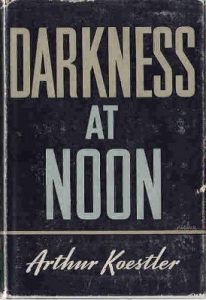
“What a mess we have made of our golden age.” — Nicholas Rubashov
This August, a now-famous photograph began circulating online. In the original, Donald Trump is seated in the oval office with a phone wedged against his ear. With him in the room are five men, his closest allies and advisors: Vice President Mike Pence, Chief of Staff Reince Priebus, Chief Strategist Steve Bannon, Press Secretary Sean Spicer, and National Security Advisor Mike Flynn. In the edited version that went around in August, giant perforated edges surround all except Trump and Pence, as though everyone close to the top had always been prepped for excision. When this photo began circulating, all of those men had been fired or removed.
Even before this image made the rounds, I had been pitching articles to various outlets about the parallels between the Trump administration and Arthur Koestler’s dystopic 1941 novel Darkness at Noon. The parallels had, after all, been abundant. As a student of 20th-century literature (and, in particular, prison literature of the 20th century) who had read the novel countless times in grad school, they had often seemed glaring to me.
The novel tells the story of Rubashov, an architect of a despotic regime, who finds himself caught in the workings of the very machine he has built. Arrested for “political divergences,” Rubashov is imprisoned in an off-the-books state-run black site, coerced into confessing to conspiracy, and eventually killed. The novel was meant to be a condemnation of Stalinism and communism in the 20th century. But like many things in the 21st century, it has taken on entirely new shades of meaning, due to the unreality of the world we find ourselves in.

Once arrested, Rubashov is taken to a “new model prison” in “a new American make” car. While imprisoned he communicates with his nearest neighbors by tapping a linguistic code through the wall. He reflects on his own past misdeeds and muses constantly on history. If pressed to choose who he most resembles in Trump’s advisory circle, it would likely be the loathsome Bannon, a self-proclaimed Leninist and quasi-intellectual. Rubashov, like Bannon, shaped much of the strategy and public discourse that was issued through the regime of No. 1, the shadowy leader who haunts the novel. Like Bannon, Rubashov believes that “the party must not join the moderates.” And like Bannon, he has a checkered past, rife with betrayals and public embarrassments. There is some degree of humanity in Rubashov, though, which is what makes him an anti-hero with continued relevance. Koestler crafts the novel in a way to reveal its vice-grip slowly, unveiling Rubashov’s damnation inch by inch both through the past and the future-to-come.
Telling are Rubashov’s thoughts on No. 1 himself. Once the architect of a political system based on logic, Rubashov sees it now fall to a “simplified, easily graspable catechism…with No. 1 as the high priest celebrating the Mass.”
His speeches and articles had, even in their style, the character of an infallible catechism; they were divided into question and answer, with a marvelous consistency in the gross simplification of the actual problems and facts. No. 1 doubtless had an instinct for applying the “Law of the relative maturity of the masses…” The dilettantes in tyranny had forced their subjects to act at command; No. 1 had taught them to think at command.
The gross simplification of problems and facts, the treatment of politics as evangelical tent-show, and the unquestioning devotion that Trump has elicited from his staunchest supporters mirrors almost directly this description of a despot who has purged everyone who has helped him obtain power.
Hauntingly, if one were to simply pull individual sentences from the novel, it could often seem to describe America in 2017, down to some stunningly accurate details. There is the fear of political leaks: “A lot of spies and provocateurs try to creep into our ranks. The party must be on its guard.” Civil confrontations with law enforcement: “conflicts with the police resulted in wounded and dead.” A rise in populism: “We were called the party of the Plebs.” Claims of “fake news”: “Often it happened that somebody protested a supposed false interpretation of what he had just said and called his neighbor to witness, with precipitate exclamations of ‘I did not say that,’ or ‘That is not what I meant.’” Even the communiques which pass between Rubashov and the prisoner in the next cell over resemble the short and direct messages of Twitter: “Rubashov occasionally tapped out a loud HA-HA! with his pince-nez as a laughter substitute.”
But most telling of all is the photograph. “A picture appeared in his mind’s eye, a big photograph in a wooden frame: the delegates of the first party of the congress…above each head was a small circle enclosing a number corresponding to a name printed underneath.” Rubashov goes on to reflect that “half the bearded men of the photograph no longer existed. Their names might not be mentioned, their memory only invoked with curses.” Rubashov himself is only the most recent of the first congress to be purged by No. 1, accused of treachery.
Trump has quickly distanced himself from anyone who might compromise his grip on authority, and since the Mueller investigation has probed deeper into his relations with Putin, we have seen how this distancing has only increased. Flynn, according to Sean Spicer, was simply “a volunteer” in the White House, despite once being a National Security Advisor. Spicer himself was gone shortly afterward, cut from the quick, like all the delegates of the first party of No. 1’s congress. “From time to time,” Koestler writes, “No. 1 reached out for a new victim among them.”
No. 1’s regime uses a single bullet to liquidate its detractors, but thankfully humanitarian policies and basic decency have prevented Trump from engaging in the outright murder or jailing of political adversaries. Though, recall, it was the chants of “lock her up” that most invigorated his base, along with his frequent laments about journalists, and how he can’t simply imprison them for their “political divergences.”
As time marches forward and potential indictments or impeachments proceed, there might still be time to avoid a full-scale reenactment of one of the bleakest novels of the last century. However, in Rubashov’s own words, “History was more of an oracle than a science,” and the divinations of history are still forthcoming. At the very least we will always have Koestler’s oracular document to remind us that the past has more to say about the present than we often realize.





Drager Meurtant says
Having visited Germany last week, and realizing how a city like Bremen had been destroyed for > half in WW-I, again, like at earlier visits to areas like Bayern, one is astonished that elections in 1933 did lead to Nazi victory. Even if not a majority, and with force taken power subsequently. One would hope, such stupid voting leading to massive terror and destruction, would not be repeated anywhere. Now, the last elections in the USA should not be compared to the situation in the Weimar Republic. But if a nuclear conflict would arise in following years, voters should re-examine their motive and effect…